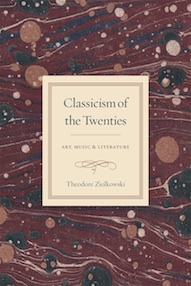By Louis J. Kern
This volume presents a closely and elegantly argued interdisciplinary recuperation of the inter-war response to romantic sensibilities and modernist aesthetics espoused by a core group of artists—composers, painters, and writers—that took the form of a return of classical forms and themes in reaction to the psychic and moral devastation of World War I. It is grounded in a sociology of art interpretation that is reminiscent of Arnold Hauser’s Sozialgeschichte der Kunst und Literatur (1951), in which Hauser, a Marxist art historian, stressed the supersedure of classical aesthetics by the modernist turn. Ziolkowski essentially turns Hauser on his head, arguing for a classical turn during the 1920s that, while not absolutely repudiating modernist sensibilities, reconstituted classicism through a renunciation of romantic sensibilities.
Ziolkowski carefully distinguishes generic classicism from its specific manifestation as “classicism of the twenties.” Generic classicism typically incorporates the negation of other aesthetic movements that exhibit unrestrained creativity and that eschew moderation and restraint. But, while earlier twentieth-century classicism stressed order, discipline, and tradition, and focused on incorporating classical themes and characters, it was, in Ziolkowski’s terms “classical without classicism.” “Classicism of the twenties,” however, prioritized classical forms as a reaction to the overwhelming social, political, and cultural devastation, personal dislocation, and spiritual disintegration of World War I.
For Ziolkowski, the heart of the “classicism of the twenties” was the annus clasicus 1922, which saw the publication of James Joyce’s Ulysses and T.S. Elioit’s The Wasteland and the premier of Igor Stravinsky’s one-act opera buffa, Marva. These three artists were joined by artists Pablo Picasso and Francis Picabia and composers Paul Hindemith and Alfredo Casella. All were déracinées, expatriates whose social and political sensibilities were essentially conservative. Their classicism stressed order and restraint, and when linked with pre-war classicism, reinforced antidemocratic and anti-Semitic tendencies attractive to Fascism. Indeed, some, like Casella, espoused a proto-Fascist politics.
In art, Picasso’s classicism did not displace his other stylistic gestures that he was able to simultaneously combine. It was not Picasso’s use of classical themes (the centaur and the Minotaur—Cf. his Minotauromachie [1935]) that define his 1920s classicism but rather his use of classical forms—a drastic reduction of his palette to a few basic colors, sharply defined lines, and overall harmony of composition. At the same time, however, his monumental human figures (an ironic exaggeration of classical Roman sculptures) and his Dionysian eroticism were indicative of another key trait of the “classicism of the twenties,” viz., the realization that the classical could not simply be repeated, that ancient harmony and aesthetic purity were finally unattainable, and that each classicism was a product of its own time and place. The attitude of the 1920s classicist towards the classic, therefore, was tinged with a certain ironic distancing.
In music, classical forms took on another meaning. Here classical forms meant not ancient models but recurrence to Baroque styles—the tonic harmonies characteristic of the sonata, eighteenth-century forms like the gavotte, and the use of chamber ensembles rather than orchestras. Focus was on musical forms; everything else was subordinated to the music.The best examples were Stravinsky’s Oedipus Rex (1927) and Casella’s Scarlattiana (1926).
Ziolkowski provides a sober reassessment of the cultural landscape of the 1920s, reclaiming the role of tradition and balance as fundamental values of a period often depicted as ethically adrift and obsessed with the superficial. While it can be read with profit by the general reader, it will probably be most useful for those with a serious interest in the cultural forms of the era and scholars.
Louis J. Kern (ΦBK, Clark University, 1965) is professor emeritus of history at Hofstra University. Hofstra University is home to the Omega of New York Chapter of Phi Beta Kappa.




